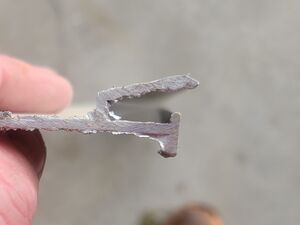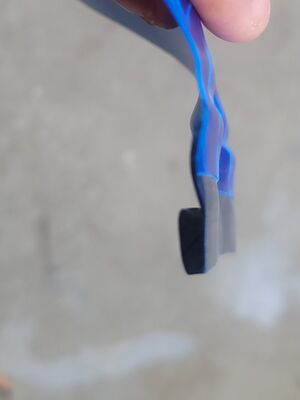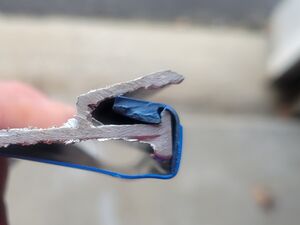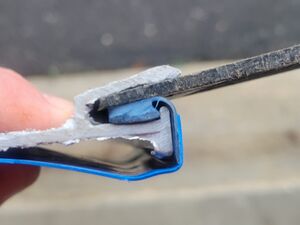Liner Replacement
To see how different liners look in the water see the Vinyl Liner Pattern Roundup Project.
CGT has a Poolside Liner and Deck Visualizer. CGT is North America’s leading manufacturer of premium vinyl for in-ground pool liners
Many pool owners consider replacing a liner a rite of passage. When hiring someone to do this, many factors must be considered.
It is risky to leave a liner pool empty for a long time, especially if rain or storms are possible. The water in the pool helps support the walls. Without the water, there is a risk a wall can buckle or fall in. If the pool will be empty, it is best to brace the walls with 2x4s and plywood.
Here are questions a member[1] developed to interview contractors:
- The pool is operational right now, and it’s not an emergency. What would be the best time to replace it – mid-season, closing, or opening next season?
- You may not have an easy way to drain all the water. Will you truck it away? If so, how much will it cost? Or can you come up with some piping to drain it into a storm drain as an alternative?
- Are you concerned about the pool floating up and breaking the deck around it when it’s empty? And if not and it happens, what will you do about it?
- What will you do about a non-functioning pool light you don’t want? Would you fill the cavity (how much extra?) or just put a new liner over it? Note that one of the most requested features is restoring a pool light that was previously filled in. So, think twice before filling in a pool light.
- Will you truck the water in, and how much will it cost, or will you use my water (~$350)? It can take a couple of days to fill the water from your line. Will you run a vacuum non-stop to keep the liner in place for the duration?
- Can you save the water in bladders for reuse?
- Do you use liner lock? Will you return to fix it if the liner comes off the track?
- How do you deal with wrinkles? Will you make sure none are present after you’re finished? How long can you be called to fix it?
- What’s your policy about leaks if there are any present afterward?
- Payment. Can I pay a deposit and the rest afterward when I’m happy with the results?
If you have a custom-made liner, your pool will need to be measured unless you have the serial number. If you have them, the serial number may be printed into the liner on its backside, typically in the shallow end near the stairs. It could also be with any paperwork left by the previous owner.
Liner thickness can be 20 mils to 30 mils, although some people say that the thicker liner does not stretch as well in the second half of its life.
UV protection on a liner is new, and we can't say if it's true; time will tell. The sunny side waterline gets beat up the worst with fading. The deeper blues fade the most with most brands. There's a gray color that Merlin Liners has that's nice and has held up great so far, its flawless.[2]
A discussion about liner materials can be found in this thread.
There are many liner manufacturers[3] including:
- looploc.com
- garrettliners.com
- McEwen Industries
- Latham Liners
- Tara Liners
- Merlin Liners
Things to consider if you are going to DIY a liner replacement:
- The critical component is ensuring your measurements are 100% accurate and the proper size liner is ordered. For a complex / irregular shaped pool, that could be the biggest challenge for a non-pro.
- What materials are your walls and floor? Steel? Fiberglass? Vermiculate?
- What repairs will your walls and floors need?
- Consider the weather. The end of the season is a great time while it's still warm out. Spring is the worst time as it's rainy and not warm enough.
- Will dewatering pumps need to be installed to lower the groundwater level around the pool to allow for repairs to be made? This may involve digging a hole in the deep end bigger than a five-gallon bucket, putting in gravel and a bucket with holes drilled around the bottom, and then putting a small pump in for a few days to dry out the deep end so repairs could be made
- You will need one or two 3 hp vacuums to pull the liner in place
- Cutting holes in a new liner isn't for the faint of heart
- Fill the water up to the level where cuts need to be made
When replacing a liner, other work to consider are:
- cleaning vermiculite
- foam
- new coping,
- new gaskets
- new skimmer faceplate
- new drain cover
- new return eyeballs
- new lights
- steps
Inground Pool DIY Liner Replacement shows how to replace a liner.
Repairing a Pool Liner
Read Vinyl Liner-Patching
Repairing a Liner Pool Floor
Liner pool floors typically have vermiculite as their base.
You can smooth out the floor with some vermiculite or mix of vermiculite and dry concrete or just some dry concrete. Use straight Portland cement for any divots or pimples. If its a big spot then you need a patch of vermiculite.
How Does a Liner Hang in its Track?
If your liner has popped out of its track, read Vinyl Liner-Out of Track A-B-Cs.
Both the liner track and liner have lips to mate up.
The liner in the picture is folded under the track to simulate the weight of the water, pulling it downward to hold it in place. Normally it just continues down the wall.
Sometimes, the liner stretches, or the water pulls on it unevenly, causing a section(s) to be loose or pop out. It can be popped or massaged back into place, and a liner lock is used to shim it tight. An actual shim is seen in the picture for visual effect only.
.





